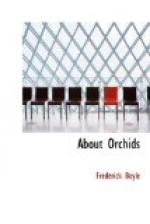only one found, I believe, outside of India and the
Eastern Tropics—also belongs to Japan,
and a cool Dendrobe,
A. arcuatum, is found
in the Transvaal; and I have reason to hope that another
or more will turn up when South Africa is thoroughly
searched. A pink Angraecum, very rarely seen,
dwells somewhere on the West Coast; the only species,
so far as I know, which is not white. It bears
the name of M. Du Chaillu, who found it—he
has forgotten where, unhappily. I took that famous
traveller to St. Albans in the hope of quickening his
recollection, and I fear I bored him afterwards with
categorical inquiries. But all was vain.
M. Du Chaillu can only recall that once on a time,
when just starting for Europe, it occurred to him to
run into the bush and strip the trees indiscriminately.
Mr. Sander was prepared to send a man expressly for
this Angraecum. The exquisite
A. Sanderianum
is a native of the Comorro Islands. No flower
could be prettier than this, nor more deliciously
scented—when scented it is! It grows
in a climate which travellers describe as Paradise,
and, in truth, it becomes such a scene. Those
who behold young plants with graceful garlands of
snowy bloom twelve to twenty inches long are prone
to fall into raptures; but imagine it as a long-established
specimen appears just now at St Albans, with racemes
drooping two and a half feet from each new growth,
clothed on either side with flowers like a double train
of white long-tailed butterflies hovering!
A.
Scottianum comes from Zanzibar, discovered, I
believe, by Sir John Kirk;
A. caudatum, from
Sierra Leone. This latter species is the nearest
rival of
A. sesquipedale, showing “tails”
ten inches long. Next in order for this characteristic
detail rank
A. Leonis and
Kotschyi—the
latter rarely grown—with seven-inch “tails;”
Scottianum and
Ellisii with six-inch;
that is to say, they ought to show such dimensions
respectively. Whether they fulfil their promise
depends upon the grower.
With the exceptions named, this family belongs to
Madagascar. It has a charming distinction, shared
by no other genus which I recall, save, in less degree,
Cattleya—every member is attractive.
But I must concentrate myself on the most striking—that
which fascinated Darwin. In the first place it
should be pointed out that savants call this
plant AEranthus sesquipedalis, not Angraecum—a
fact useful to know, but unimportant to ordinary mortals.
It was discovered by the Rev. Mr. Ellis, and sent
home alive, nearly thirty years ago; but civilized
mankind has not yet done wondering at it. The
stately growth, the magnificent green-white flowers,
command admiration at a glance, but the “tail,”
or spur, offers a problem of which the thoughtful never
tire. It is commonly ten inches long, sometimes
fourteen inches, and at home, I have been told, even
longer; about the thickness of a goose-quill, hollow,




